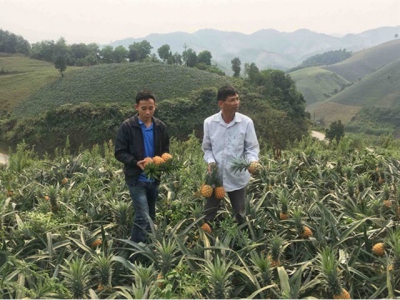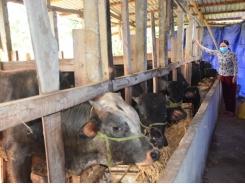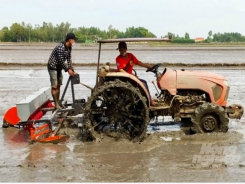Lao Cai has headache with over 40,000 tons of pineapple per year

As an international trade border gate with China, Lao Cai Province has great potential for developing a variety of agricultural, forestry, and fishery products.
Lao Cai has up to 1,600 hectares of pineapples with an output of about 40,000 tons. Photo: Ke Toai.
On April 1, 2021, the Lao Cai People's Committee approved a "Project on developing the agricultural and forestry processing network in the province for the period 2021 - 2025".
The project aims to focus on investing and developing key products, associated with branding to promote and introduce them to the market.
Accordingly, 12 key products include 7 of agriculture (tea, vegetables, fruits, rice, medicinal plants, livestock, and aquatic products) and 5 of forestry (furniture, cinnamon, bamboo shoot, truffle oil, and white antler resin).
Speaking at a forum to promote the connection for production and consumption of agricultural products and vegetables in the North (the 16th session of the Agricultural Product Connection Forum 970) held on December 18, Mr. Vuong Tien Sy, Head of Lao Cai Sub-Department of Agriculture, Forestry and Fishery Quality Management said that two of the province's strong agricultural products, tea, and bananas, have been consumed abroad. In which, bananas are officially exported to China while tea is to the Middle East and Europe.
In the coming time, Lao Cai will continue to invest, produce, process and create regional linkage chains, especially for agricultural products. The province is expected to apply many modern farming processes such as those in organic agriculture, setting up planting area codes, and promoting digital and science and technology transformation.
As the province has many distinct climate sub-regions, it has potential for development, especially cold-water fish with an output of about 700 tons.
However, Lao Cai is now facing a pineapple issue with about 1,600 hectares of cultivation and over 40,000 tons of output. While this product has not been officially exported to China, processing factories currently only consume one-third of the total output. The province thus is having to distribute through small retail channels in the country.
"The province is looking forward to connecting with neighboring localities and China, especially for consuming products manufactured following advanced processes, ensuring quality," said Mr. Sy.
A Conference was held recently on the implementation of the Provincial Standing Party Committee’s Resolution No. 10-NQ-TU dated August 26, 2021, on the strategy of agricultural commodity development in Lao Cai to 2030, with a vision to 2050. Speaking at the conference, the Chairman of the provincial People's Committee, Mr. Trinh Xuan Truong emphasized one more task of promoting production associated with processing, gradually shifting to commodity agricultural production along with restructuring into highly efficient crop varieties.
In the short time by 2025, Lao Cai will develop agricultural, forestry, and fishery processing facilities, build 4 processing factories installed with modern machinery and equipment, apply high and advanced technology in processing and preserving agricultural and forestry products. After 2025, localities will focus on upgrading and developing more modern facilities to increase processing capacity especially for a number of key commodities such as medicinal herbs, tea, cinnamon, cattle, and poultry meat...
As a gateway connecting China with the ASEAN region, the amount of agricultural products passing through Lao Cai is very large. Therefore, the province wants the Government, the Ministry of Agriculture and Rural Development (MARD), and related ministries, departments, and agencies to study logistic constructions, exhibitions, and display zones for agricultural products. Lao Cai has set aside more than 300 hectares of land to prepare for this plan.
Areas selected for implementing the plan are located in advantaged localities near Noi Bai - Lao Cai Highway, Sa Pa Airport, and border gates such as those in Tan Thuong Commune (Van Ban District), Cam Con Commune (Bao Yen Yen District), Phong Nien Commune, Lu Bao Thang town and Ban Vuoc Commune (Bat Xat District), and Kim Thanh (Lao Cai City).
In addition, Lao Cai proposed the MARD to have an adjustment policy to avoid local congestion of products from the South, at the same time to negotiate soon with China so that the province can officially export pineapple and cinnamon products to this country. Lao Cai has been now actively promoting domestic consumption with many products having been transported to Hanoi for sales.
Director of Bat Xat District Agricultural Service Center, Mr. Luc Nhu Trung, said that the district’s soil conditions are favorable for developing typical agricultural products in the northern mountainous region.
The district has 1,500 ha of banana, of which 1,000 ha have been certified with VietGAP standard. Currently, it yields an average of 300-500 tons per month, mainly sold to China. Moreover, Bat Xat has 3,000 ha of Seng Cu specialty rice, more than 100 ha of over 20 types of medicinal herbs and 800 hectares of off-season vegetables.
Related news
Tools

Phối trộn thức ăn chăn nuôi

Pha dung dịch thủy canh

Định mức cho tôm ăn

Phối trộn phân bón NPK

Xác định tỷ lệ tôm sống

Chuyển đổi đơn vị phân bón

Xác định công suất sục khí

Chuyển đổi đơn vị tôm

Tính diện tích nhà kính

Tính thể tích ao




 Farmers benefited from the irrigated agriculture improvement project
Farmers benefited from the irrigated agriculture improvement project  Rice production by sowing tray, planting machine helps…
Rice production by sowing tray, planting machine helps…